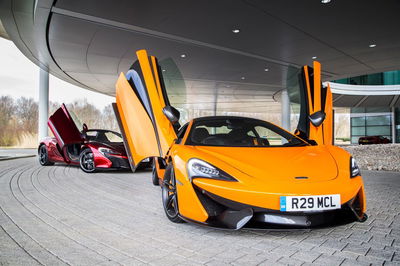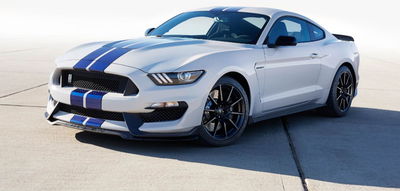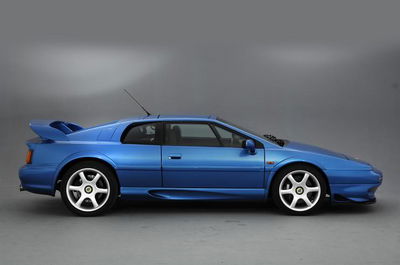6 Of The Greatest Flat-Plane Crank V8s Of All Time

V8 engines are the lovechild of the car world, warbling their way into the hearts of most petrolheads. Most prominent in America, the V8 has morphed into an effective performance engine, taking advantage of large displacement and endless tuneability to become the go-to for muscle cars. V8s originally were built with flat-plane crankshafts, with the crank pins situated at 180 degrees to each other. But soon manufacturers began to produce cross-plane crankshafts that set the crank pins at 90 degrees to each other.
Cross-plane crankshafts allowed for a more balanced powertrain, with much less unwanted vibration being produced compared to a flat-plane setup. On the other hand, cross-plane cranks are inherently larger and heavier, with additional balancing weights used to create their epic smoothness.
A lighter flat-plane crankshaft can spin much faster and more easily than a heavily weighted cross-plane setup. This is therefore the reason why modern performance car manufacturers have started leaning towards flat-plane cranks, as engine technology has reached a point where a little vibration and harshness is easily sacrificed if it means a nicely responsive and revvy engine.
So to celebrate the talents of these screaming, operatic engines, here is a quick list of the greatest cars to feature a flat-plane V8!
McLaren P1

The flagship hypercar from McLaren manages to amass a 727bhp output from its flat-plane V8 in conjunction with an electric motor adding the equivalent of 177bhp in to the mix. A prod on the throttle will see all 904bhp from McLaren’s M838T twin-turbocharged unit take you from 0-124mph in just 6.8 seconds and on to an electronically-limited top speed of 218mph. With McLaren claiming a derestricted limit of 249mph, the P1 is an aero-tastic middle finger to the best from Maranello and Stuttgart.
Ferrari’s F136 V8 featured in some stunning cars during the noughties, with Maserati and Alfa Romeo using cross-plane crankshaft versions in cars like the Granturismo and 8C. Ferrari however decided to mix things up by using a flat-plane crank instead, creating some of the greatest engine vocals of all time. Featured in the F430, this V8 stepped up power from the Ferrari 360 to 483bhp at a stupidly high 8500rpm. Couple that powertrain with the rarely-specced manual gearbox and you have yourself a bona fide supercar legend.
Ford Mustang Shelby GT350

A break from the norm of cross-plane cranks in muscle cars, Ford unveiled the latest GT350 with a 5.2-litre naturally-aspirated V8 featuring a flat-plane crankshaft. The 32-valve DOHC ‘Voodoo’ powertrain pumps out 526bhp at a crazy 7500rpm, making the GT350 a sub-$60,000 performance car bargain. Ford has finally produced a Mustang that the European automakers should take seriously, and it’s all down to a beautifully responsive, free-revving V8.
Barely scraping the specifications needed to meet the credentials to be classed as a ‘road car’, this track-focussed weapon has put a flat-plane crank V8 at the top of the Nurburgring lap record board. Smashing any and all road car competition with its scintillating 6 minute 48 second lap, the Radical has created an eight-second lead between itself and second place.
Using a 2.8-litre variant of RPE’s V8 outputting over 430bhp, the SR8LM is capable of a sub-3 second 0-60mph time and took the Pikes Peak hill climb title in 2015.
Porsche 918 Sypder

With Ferrari and McLaren not seeming to bother with a Nurburgring lap time, the 918 Spyder has left its counterparts behind with its 6 minute 57 second lap. Using all of its 600 IC horsepower from a flat-plane crank V8, two electric motors are then introduced to bring total output to 875bhp (887PS).
With an all-wheel drive system shifting electric and combustion power to exactly where it is needed, the 918 has roasted nearly every other supercar or hypercar over the quarter-mile, with claims of 0-60mph times of just 2.2 seconds. Gather together all of the 918’s achievements since its launch and it can be seen as one of the greatest automotive accomplishments of the decade thus far.
Lotus Esprit V8

After messing around with NA and turbocharged inline-four engines, Lotus decided that it was time to turn the then-20-year-old Esprit up to 11 by throwing in a massive 3.5-litre twin-turbocharged V8 behind the cockpit. Using a flat-plane crank and a 90-degree V configuration, the British bruiser was apparently capable of being tuned to around 500bhp, but due to a weak transmission picked from the Renault parts bin, the production Esprit was anchored down to a more tyre-friendly 350bhp. The 918 variant of the Lotus 900-Series engine line unfortunately never saw action in any other production car, making the Esprit V8 Britain’s own little unicorn.

What is your preference when it comes to V8s? Are you a fan of a spluttering American lump with huge displacement and a cross-plane crank or a turbocharged, spine-tingling flat-plane unit from the likes of Ferrari and McLaren? Comment with your thoughts below!














Comments
TVR Cerbera and his magnificent TVR AJP V8
Enter your comment…
I wonder
Love the sound of the Mustang Flatplane V8
A V8 that’s also high-revving? What else does a carguy need for a perfect life?
Well, you don’t NEED it to be flatplane to rev super high. Audi’s 4.2 V8 actually revs 50RPM higher than the GT 350’s, and that’s just a regular cross-plane.
more cylinders :)
Porsche 918 Sypder though
Flat plane crank sound soooooo much better
is Atom 500 V8 flat or cross?
With a redline of 8,200rpm you can now eat crowds at the revolution of a stock rotary.
Sorry.
need to stop
That’s a Shelby GT350r not GT350
No it isn’t. The R has a bigger rear wing, different (carbon fiber) wheels and all of the Shelby badges are red in the R
Ey, Lotus Esprit! I love that thing. :D
The GT350 is not a muscle car.
It’s like no one knows what a pony car is.
Pagination